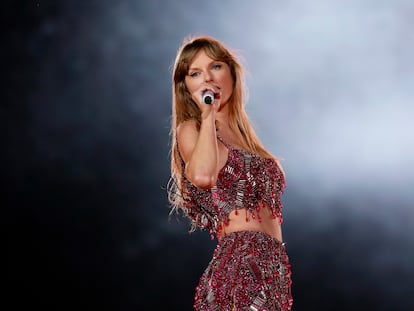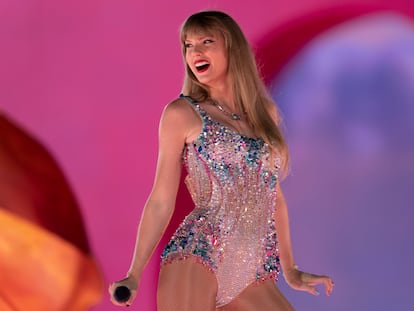Scenes from Taylor Swift’s last US concert: Eight minutes of applause and a long-awaited announcement
The 33-year-old singer filled the SoFi Stadium in LA for six consecutive nights with an exquisite, meticulous show that has become an act of communion for her thousands of followers
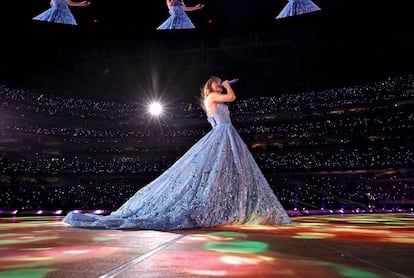

Taylor Swift is a religion. Beyond the music, beyond the show, beyond the songs and lyrics, beyond the intricate video clips and the conspiracy theories about her and her compositions, the 33-year-old singer from Pennsylvania has become a creed for hundreds of thousands of people (a quick calculation estimates around three million) who have devoutly attended, just across the United States, the 53 concerts of The Eras Tour, her sixth one, which took her from Arizona, in March, to the last stop this Wednesday in Los Angeles, California, after six sold-out nights at the state-of-the-art SoFi Stadium. An evening in which thousands of voices wore their best — there is no one who does not dress up and blend in with the Swiftie atmosphere — to listen to 45 songs and receive one of those surprises that, coming from her, are not so surprising: the news that she will re-record one of her most successful albums, 1989, released in 2014 (many of her songs were sold without her knowledge or consent to an investment fund), and will release it on October 27.
Swift filled a SoFi that showered her with shouts and applause since the countdown clock appeared on the main screen. Up to 70,000 people, a vast majority of them women, went dressed in cowboy boots, t-shirts with her phrases, shiny sequined t-shirts and gold, red and purple dresses, each outfit alluding to one of her eras, albums or stages, because for this tour she gathered the greatest songs from her 10 records and devoted a section to each one. “I used to make an album and go on tour, and then I made another and went out again,” the artist explained on the vast stage of the stadium, talking about how the Covid-19 pandemic kept her from promoting her seventh album, Lover. Since then, she has released three more, which did not have their own tours. “So people would tell me: what are you going to do with them, sing all that music, which is like three hours? That is the plan, exactly that, and it will be called The Eras Tour,” she said, to the delight of the fans.
The venue opened at 4:30 p.m., with people already crowding the doors. At 6:30 p.m. the opening act started with Gayle and the band Haim. Minutes before Swift herself came out, at almost 8:00 p.m., a couple stood in line to buy some drinks. They were Cass and Josh, originally from New Orleans but living in Los Angeles, with Mardi Gras-inspired lilac outfits with feathers and sequins. “We are very excited,” confessed Cass. They had also gone the previous night. A few feet from them, Lauren and Sivan, both in their thirties, one wearing a t-shirt with lyrics and the other with a cowgirl hat, waited to buy something to eat. They are from Los Angeles and just had to go to the concert, they said. So, having no tickets, they dressed up to see Swift and stood at the gates of the stadium. In the end, they found a couple of tickets online. The price of their whim: $1,700 each. “But it’s worth it. Really worth it,” they claimed in unison.

At 8:00 p.m. there was not a free seat in the house. Not that anybody was using theirs — the entire stadium was on its feet, with fans exchanging homemade friendship bracelets, just like the ones Swift mentions in her song You’re On Your Own, Kid, one of the best from Midnights, her latest album, and one of her greatest hits, although, surprisingly, one that she seldom sang on this tour. She started with Miss Americana, from her album Lover, and finished with Karma, from Midnights.
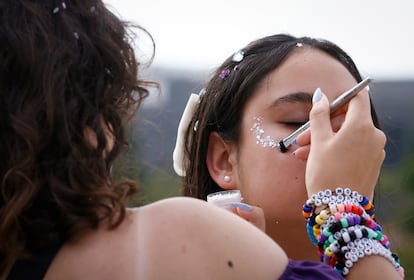
Eight o’clock and nine minutes past, in the eighth month and the ninth day. It is no coincidence. With Swift, nothing ever is. Those are the same numbers in the title of 1989, which is also her year of birth. If each stage, each era, each album is associated with a color or an aesthetic, 1989 is associated with blue. The singer comes out dressed in a huge blue dress (it is new — the Swifties see and discuss everything), to sing the songs from the album Speak Now. Much more blue clothes than in others shows; even the stadium has been dyed blue with the lights from the attendees’ bracelets. Then, the long-awaited announcement of the new album comes, and even the outside of the stadium is decorated with its title. It happens after she sings New Romantics, a classic from that album that she had saved, quite intentionally, for that last date.
Because with Taylor Swift, more than a concert, one gets a meticulous show of more than three hours of music, dance, speeches, endless applause (the ovation in Champagne Problems lasted eight minutes before she interrupted it, either out of modesty or simply because the show had to go on), cabaret-like numbers, videos created for the precise moment, perfect transitions between albums, refined staging with cabins, burning beds, stages that go up and down, colorful guitars, bicycles, a train blowing smoke on the huge screen behind her... Meanwhile, Swift sings, but also dances, changes her clothes, plays the guitar or the piano (pianos: there is one that is full of moss, for instance, and a wooden one with hippie touches) and gestures to the fans. Her vocal ability goes hand in hand with her body language, with each song turned into a small four-minute performance.

Everything has been calculated, and it works out perfectly. Each song has a specific place (the list, in the right order, can be found on Spotify) and the audience knows well how to receive them, how to enjoy them and their nods to particular details. They are always the same 43, although for the California concerts she replaced one with another with her “best friends,” the Haim sisters, and there are two encores that the fans bet on, as she does not usually repeat them more than twice.
The fans are key to the Swift phenomenon. In a stadium full of friends and celebrities (from Emma Stone, Becky G and Alanis Morissette to Karlie Kloss, first a friend, then an enemy and now, apparently, a friend again), Swift made a point of recognizing something that has been escalating and that has been clearly felt in this last concert: that the tour was an overwhelming success thanks to the community of fans. “Many people came to these concerts for you, for the joy, the friendship, the atmosphere,” she stated, excited. “It is you who are making this tour. You make friends with the people sitting next to you. It’s beautiful. For me, the most beautiful thing in the world is how you come excited, you dress like this… it is very special for me and for all of us who do it,” she said, expressing her gratitude over and over again. As soon as the show started, she also took time to thank her crew, among which she distributed bonuses totaling $55 million.
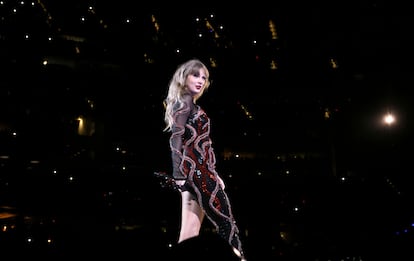
Swift knows how to make community, but also fortune and press. She generates almost a headline per concert. This time it was the return of her long-awaited album, which will have five new songs; in Seattle, it was that her fans shook the ground so hard that they generated the seismic activity of a 2.3 magnitude earthquake; in Canada, that even Trudeau asked her to perform there — and succeeded, with the tickets being resold in Toronto for more than $90,000 each. Bloomberg estimates that she makes more than $13 million per concert; the tour, which now continues through Latin America (next August 24 she starts with four concerts in Mexico, then three in Buenos Aires and six in Brazil) before heading to Asia and Europe (where there will be 78 shows) and returning in November to the last nine dates in the U.S. to finally close with six in Canada, is expected to raise $1 billion. There are 110 concerts left to see if the cult of Swift spreads throughout the world, but given the fever and, above all, the number of tickets sold, it seems that there is no stopping her.
Sign up for our weekly newsletter to get more English-language news coverage from EL PAÍS USA Edition
Tu suscripción se está usando en otro dispositivo
¿Quieres añadir otro usuario a tu suscripción?
Si continúas leyendo en este dispositivo, no se podrá leer en el otro.
FlechaTu suscripción se está usando en otro dispositivo y solo puedes acceder a EL PAÍS desde un dispositivo a la vez.
Si quieres compartir tu cuenta, cambia tu suscripción a la modalidad Premium, así podrás añadir otro usuario. Cada uno accederá con su propia cuenta de email, lo que os permitirá personalizar vuestra experiencia en EL PAÍS.
¿Tienes una suscripción de empresa? Accede aquí para contratar más cuentas.
En el caso de no saber quién está usando tu cuenta, te recomendamos cambiar tu contraseña aquí.
Si decides continuar compartiendo tu cuenta, este mensaje se mostrará en tu dispositivo y en el de la otra persona que está usando tu cuenta de forma indefinida, afectando a tu experiencia de lectura. Puedes consultar aquí los términos y condiciones de la suscripción digital.
More information
Archived In
Últimas noticias
There is as much life left to discover on planet Earth as that which is already known
Dozens presumed dead, around 100 injured in fire at Swiss Alps bar during New Year’s celebration
Is porn for women different from conventional porn? We spoke to those who make it
Cartagena de Indias is sinking: What can the city do to mitigate it?
Most viewed
- Sinaloa Cartel war is taking its toll on Los Chapitos
- Reinhard Genzel, Nobel laureate in physics: ‘One-minute videos will never give you the truth’
- Oona Chaplin: ‘I told James Cameron that I was living in a treehouse and starting a permaculture project with a friend’
- David King, chemist: ‘There are scientists studying how to cool the planet; nobody should stop these experiments from happening’
- Why the price of coffee has skyrocketed: from Brazilian plantations to specialty coffee houses
